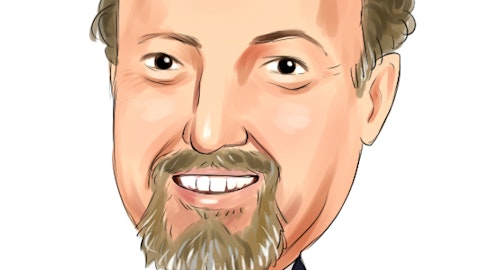Operator: And we will go to the next line Travis Steed, Bank of America. Please go ahead.
Travis Steed: I wanted to ask a little bit more color on the strong Xi placements in the capital environment even ahead of the dV 5 launch. And it sounded like the message changed on system placements in 2023 or 2024. I think before it was system placements could be lower in 2024, and now it’s just choppy. So does that mean there’s a chance that system placements are up in 2024?
Jamie Samath: Yes, I mean…
Gary Guthart: Jamie, why don’t I.
Jamie Samath: Oh, go ahead, Gary.
Gary Guthart: No, Jamie, go ahead and take it, apologies.
Jamie Samath: Yes. I think the first dynamic is trading-ins. Given the limited supply in dV 5, those placements will be, during the measured launch, focused on incremental placements. So not a lot of trade activity coming from dV 5. And if you look at what’s left in the install base for our third gen SI, you’ve got about 350 systems globally, of which 50 are in the U.S. So we do expect trading volumes to be down quite a bit in ‘24. With respect to overall system placements, I know we made the comments on the last call, but generally we don’t guide system placements, so we’ll let you run that through your models given the updated procedure guidance. But certainly we’ve acknowledged that placements could be choppy, while we’re constrained on dv 5.
In Q1, we didn’t really see any customers pushing back on I don’t want an Xi, we want to wait for dV 5. But since the launch, which obviously was only in March, we’ve had our Connect conference, we’ve had SAGES this week, a significant number of surgeons and executives have now seen dV 5 put their hands on it. So we’re acknowledging that customers may choose to wait. We don’t have enough evidence or indication yet to see which way that will go.
Travis Steed: Great. Maybe, Gary, you could spend some time, just kind of a bigger picture question on dV 5 and the capabilities it brings to training, being able to practice some of the edge cases, helping with proctoring. I’m just curious how you see the impact on robotic surgery adoption and driving better outcomes from some of those dV 5 training capabilities that’s going to roll out and how long some of this stuff actually is going to take?
Gary Guthart: In terms of raw capability, I think that it will help care teams acquire skills more quickly and it also helps them in the case. As you can kind of think of that as contact sensitive help. The device is kind of aware of where it is and what it’s doing and can share that information with the care team, so that as they’re doing things, whether it’s changing tools or setting it up, it provides real-time help to help guide them through it. And I think that’s a really good thing. It just makes it easier to use. Our Intuitive hub has integration, technologies that start with da Vinci 5 and will get better over time as we release software updates and hardware updates. And so that starts to close an analytical loop for our customers from what they’re seeing in the case to video review to video analytics to feeding back information to their phones and their laptops and whatever their means are consuming that data is.
So that gives them an analytical loop, which should also help. And we’ll also continue to evolve our simulation training and some of our other packages, our online learning, that will help them as well. So I think all of this is going to take a little bit of time, but I think the design concept, I think our designers did a beautiful job. I think the design concept of integrating these ideas, making it easy for care teams, for surgeons to follow that journey should help us. Final point I’ll make is that in our labs and during our early experience with da Vinci 5, it looks like forced reflection helps novice, new to robotics, new to robotics assistant surgery, require their skills faster. So it should invite more surgeons in and ease their journey.
It remains to be proven. It’s not done and done, but we think it’s encouraging. And so stay tuned. I think keep asking that question and as the data starts to come out, we’ll be pleased to share it with you.
Travis Steed: Great. We will wait to see and congrats.
Operator: Okay, and we’ll go to the next line. Rick Wise, Stifel. Please go ahead.
Rick Wise: Good afternoon. Hi, Gary. Maybe it would be helpful to hear in a little more detail your thoughts on a couple of points that maybe some of the headwinds. Bariatrics flat year-over-year, I wasn’t sure completely what I was hearing about trends. Is it getting worse still? Does the — is the rate of pressure easing? I appreciate in talking about the guidance you talked about, a range, given the range of outcomes, but I assure make sure I understood what you are seeing?
Gary Guthart: Yes, let me share my perspective. Rick, thanks for the question, and then Brian, I’ll kick it to you to talk about the range. I think what we can tell you is what we see and what we’ve seen is continued deceleration such that it’s flat year-over-year. There are a lot of opinions out in the field and we can all talk to them. I think the reality is nobody really knows yet. We’re going to have to look through it together and as a result it’s going to be dynamic. We do know that bariatric surgery is well tolerated and it’s a good option and we also know that people are interested in pharmaceuticals and that the pharmaceuticals work as long as you take them for a subset of the population and then stop working if you don’t.
What that means for future surgery, I think there’s a range of opinions and I would not hang a lot of confidence on any of them just yet. And that’s why we have a range. And Brian, perhaps you can just touch on how you see bariatric surgery affecting the range. Just reiterate that, if you would.
Brian King: Sure. And just to reiterate again, the low end of the range assumes that there’s further weakness in bariatric procedures, right? So at the low end of the range, further weakness in bariatric procedures. At the high end of the range, we assume that bariatrics continues at flat to slightly positive growth rates. And I think, again, to Gary’s point, it will be dynamic and we’re just going to have to see how it plays out throughout the year.





